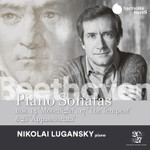|
Back
02/12/2022
“Beethoven Piano Sonatas: Volume 2"
Ludwig van Beethoven: Piano Sonata in C-Sharp minor, “Moonlight”, opus 27, n° 2 – Piano Sonata in D minor, “Tempest”, opus 31, n° 2 – Piano Sonata in F minor, “Appassionata”, opus 57
Nikolai Lugansky (piano)
Recording: July 2021, Teatro Ristori, Verona, Italy (July 2021) – 68’03
harmonia mundi HMM 902442 (Distributed by PIAS) – Booklet in French, English and German

   
Nikolai Lugansky’s recent recording of three of the Beethoven Piano Sonatas with nicknames—“Moonlight”, “Appassionata” and “Tempest”—is a showcase for this extraordinary pianist’s range of technical skill and emotional breadth. Although there are times when the piano sounds too metallic, and intensity devolves into pounding, Lugansky displays a breathtaking command of some of the richest material in the piano repertoire. This display increases as the album progresses, with—at its best—amazing performances of the conclusion of the “Appassionata” and the entire (underrated) “Tempest” Sonata. Born in Moscow, Lugansky has won top awards in major international piano competitions including the Tchaikovsky competition. In this album, he scales a peak seldom, if ever, surpassed for an ineffable blend of ecstasy and sheer ferocity.
The album begins tamely enough with the second of the quasi una fantasia Sonatas, opus 27, n° 2, in C-Sharp minor, called “Moonlight” by admirers who perhaps hear in the opening movement the shimmer of moonlight on water (Beethoven did not give these sonatas their popular names). This work, with its rolling, almost hypnotic triplets, has been performed so often that one is amazed to still be swayed by its beauty and variety. Yet swayed we are, with Lugansky’s strong interpretation of the first movement, the playful second, and a third full of precise articulations of stormy impetuosity. Whatever one’s preferences may be for an approach to this Sonata (and I confess I prefer an opening with a dreamier, more romantic perspective), this is a strong, valid presentation of material that, while familiar, is ever new.
Even bolder than the finale of the ”Moonlight” is the opening movement of the ”Appassionata”, opus 57. An inescapable sense of agitation, fluctuating between dramatic attacks on the keyboard and fluttering notes in the upper register, dominates Lugansky’s performance of this aptly named sonata. At times, the brilliance approaches shrillness, but Lugansky delivers Beethoven’s unrelenting energy into the third and final movement with purpose and power. I jotted down only two words during the final movement of opus 57: “Simply phenomenal.”
After a few seconds of recovery between works, an elegant halo of tones produced by pedal and delicately brushed keys leads into the sanctum sanctorum of the ”Tempest” Sonata, opus 31, n° 2. This has long been one of my favorite piano sonatas, a resilient work filled with remarkable effects able to endure and embrace various levels of interpretation, from the straight-forward and literal to the unabashedly eccentric. Although Beethoven didn’t specifically name this work, he supposedly said, “Just read Shakespeare’s The Tempest,” when asked about the Sonata’s meaning. But does a sublime work of music, knowable on its own terms without a program, have meaning other than the gossamer web of beauty it crochets from invisible tones?
Lugansky’s reading of this work may be a little less mystical and romantic than would be my preference, but it is a performance of great character, technical dexterity, and depth. Even without the challenges of interpretation, one wonders how anyone could follow some of Beethoven’s musical notations, such as two measures near the ending of the first movement. Here, three sustained staccato half notes are accompanied by the Italian term for “heavy” and a crescendo that immediately reverts to a pianissimo. The composer’s relentless use of syncopations, delicate runs and the half-unexpected single line that could be played with one finger provides a daunting minefield for the performer. Yet, these form a welcome obstacle course that Lugansky navigates without a hitch with the strength and grace of a gold-medal athlete. Though it may not be the preferred style of every listener, ultimately this is what piano playing is all about.
Linda Holt
|